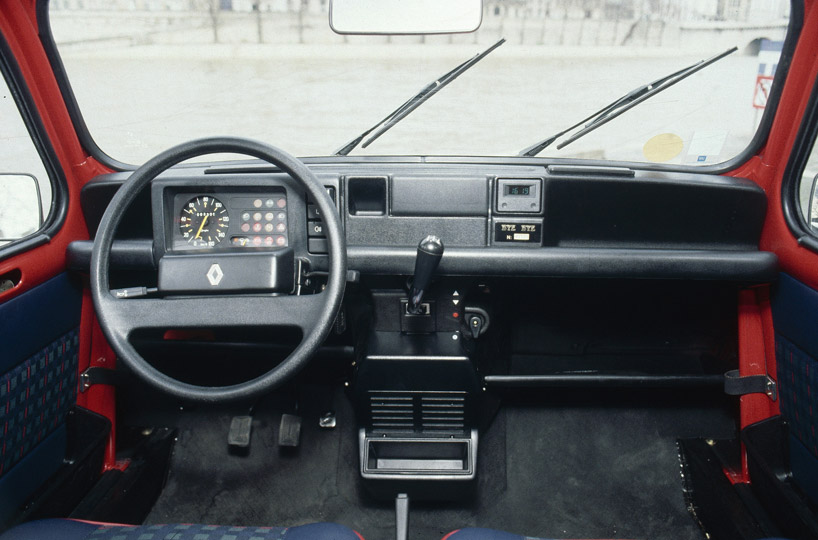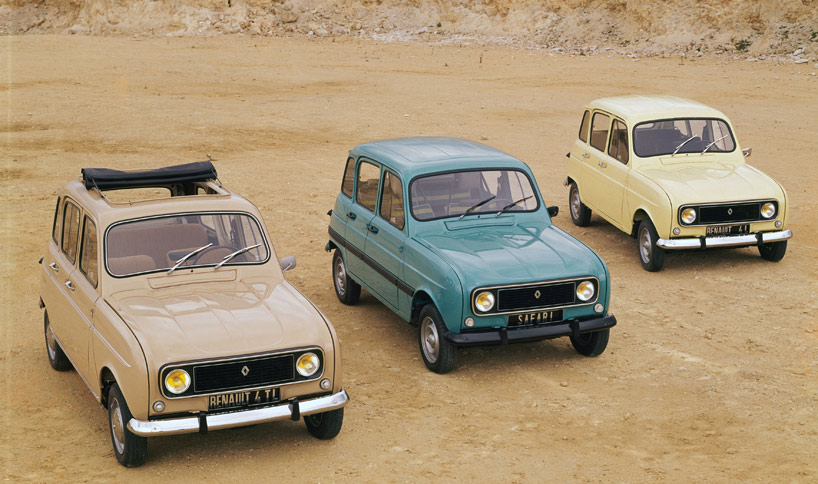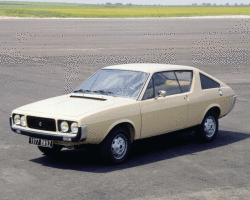the renault 4 celebrates its 50th anniversary
as the third bestselling model in automobile history (it sits behind the volkswagen beetle and ford model T to take that honour) and the bestselling french car across the world with sales in excess of eight million units in more than 100 countries, the renault 4 has become a style icon. the renault 4, invented in 1956 by pierre dreyfus, who wanted to produce a versatile, inexpensive car with a worldwide calling which could match the changes in society that were being observed as the 1960s approached. he launched the notion of a ‘blue jeans’ car.
 renault 4 clan ‘bye bye’, 1992. the historic exhibition in renault‘s headquarter office in boulogne-billancourt, paris features the no. 0001 of the the last limited series (of total 1000). the model continued to be manufactured in slovenia and morocco, until 1994, although only in small numbers. image © designboom
renault 4 clan ‘bye bye’, 1992. the historic exhibition in renault‘s headquarter office in boulogne-billancourt, paris features the no. 0001 of the the last limited series (of total 1000). the model continued to be manufactured in slovenia and morocco, until 1994, although only in small numbers. image © designboom
following a five-year incubation period, the renault 4, the first renault front-wheel drive passenger car, was on display at the 1961 paris motor show. a van and three trade versions were launched simultaneously: the R3, which was dropped from the catalogue the following year, the R4 and the R4L (L = luxury).
 renault 4 clan ‘bye bye’ image © designboom
renault 4 clan ‘bye bye’ image © designboom
during the long period when it was available for sale, the renault 4 was made in several different versions, including a van, a four-wheel drive vehicle and a cabriolet. other variants, such as the rodeo, and a long list of limited editions were also released, the best known of which in france were: the parisienne (1963), the safari (1975), the jogging (1981) and the sixties (1985).
 renault 3, 1961. straight four engine, 603 cc, 20 hp at 4700 rpm. transmission: 3-speed manual gearbox + reverse. restored by renault classic. image © designboom
renault 3, 1961. straight four engine, 603 cc, 20 hp at 4700 rpm. transmission: 3-speed manual gearbox + reverse. restored by renault classic. image © designboom
a more slimmed down model was the renault 3 also of 1961. the purpose was to offer an even less expensive version with three fiscal hp.
 renault 3 image © designboom
renault 3 image © designboom
at the end of the fifties, cars underwent profound changes and at renault, the 4CV is showing its age and the rear engine does not facilitate its use as a utility vehicle. both presented in july 1961, the Renault 3 and 4 are complemented by a luxury version with six side windows, whose name, 4L, will be adopted by the public for the entire range. it is the first car from the company with front-wheel drive (following the estafette utility vehicle), it has a flat floor pan and a hatchback. its sealed cooling circuit and its no-lubrication couplings reduce maintenance to the strict minimum.
 large flowers and the ‘peace and love symbol’ image © designboom
large flowers and the ‘peace and love symbol’ image © designboom
in the exhibition ‘modulo 4’, to illustrate two different lifestyles, that were associated to the renault 4, the histoire & collection department has created a unique model. while the rear has all the characteristics of the famous model ‘parsienne’, primarily aimed at an urban and female customer base, the front boasts large flowers and the ‘peace and love symbol’ to evoke the ’70ies.
 the famous model ‘parsienne’ image © designboom
the famous model ‘parsienne’ image © designboom
dreyfus wanted a car that was suited to the needs of a fast-changing society. people everywhere were leaving the countryside behind in a vast movement in which modernity began with rural exodus. these new urbanites did not settle only in the town centres; but headed for new urban districts that were starting to expand and morph into suburbs. it was a new world where the population was becoming increasingly active and a new middle class was burgeoning. it was the end of city cars being dramatically different from country cars; the time had come to invent versatile models, although this notion wasn’t restricted to cabin space.
 close-up to the ‘parsienne’ image © designboom
close-up to the ‘parsienne’ image © designboom
the onslaught of built-up areas and the lack of public transport networks saw automobiles begin to play a prominent role. they needed to be workhorses from monday to friday, but also fulfill the leisure requirements of families on weekends and during holidays. a slow but significant development which became more pronounced over the years was the changing role of women in society. with full employment, the addition of a second income shook up social categories and family models. it sped up consumption – idem for cars. not only did the number of driving licenses finally start to balance out between the sexes, but women also began using automobiles, which led to them playing a decisive role in their purchase.
 historic photo of renault 4 morphing into the ‘parsienne’ – urban but not snobby, utilitarian but not rough.
historic photo of renault 4 morphing into the ‘parsienne’ – urban but not snobby, utilitarian but not rough.
 the renault 4 production exceeded the 1 million mark, renault sold over eight million models in 31 years.
the renault 4 production exceeded the 1 million mark, renault sold over eight million models in 31 years.
just six years after its launch, the renault 4 production exceeded the 1 million mark, other records were broken as the car reached a total production figure of 8,135,424 in the course of its 31-year career. the renault 4 was just as successful outside of france and was produced or assembled in no fewer than 27 countries (in addition to france, in australia, south africa, chile and the philippines…) indeed, six in ten sales were outside of renault’s home market.
 the renault 4 service vacances / holiday service
the renault 4 service vacances / holiday service
 the R4L (L = luxury), front and back view
the R4L (L = luxury), front and back view
 spacious design
spacious design
 renault 4’s dashboard – left early 60’s, right mid 70’s
renault 4’s dashboard – left early 60’s, right mid 70’s
 renault 4’s dashboard – late 80’s
renault 4’s dashboard – late 80’s
 its compact size, the spartan but functional interior and the ability to adapt to all types of use made the renault 4 an instant hit
its compact size, the spartan but functional interior and the ability to adapt to all types of use made the renault 4 an instant hit
to solve the issue of producing three versions, renault explored the idea of creating a platform-type chassis with an as-yet vague notion of interchangeable bodies. the idea of a monocoque structure – seen as necessary to minimize body weight and production costs – was dropped. instead, a revolutionary approach to body design saw the light of day, giving customers the possibility to specify the configuration of their vehicle. this off-the-peg approach led to renault’s dealers fitting elements that distinguished between the saloon, semi-van and van models as a function of the customer’s wishes. an other key choice was the aaption of a system that should be removable and interchangeable, which essentially means front-wheel.
 production until 1992. renault announced the end of the renault 4 in a press release; only two factories would continue to produce the renault 4 after that date and through 1994: morocco and slovenia.
production until 1992. renault announced the end of the renault 4 in a press release; only two factories would continue to produce the renault 4 after that date and through 1994: morocco and slovenia.
 daily use
daily use
to make the car versatile, the first idea was the flat floor, which facilitated loading. this naturally led to three other features: the lack of a rear end panel, an extremely low sill and a ‘back entrance’ which would go on to be known as a tailgate. renault was inventing the two-volume vehicle with an engine compartment and a combined cabin/boot. the interior space could then evolve according to the needs of the moment by folding the rear bench seat to convert the family car into a van, or vice-versa.
 white or grey for skilled contractors, dark blue for the gendarmerie, sky blue for EDF-GDF and bright yellow for the postal service: the renault 4 wore the colours of its employers without undermining its hardworking spirit.
white or grey for skilled contractors, dark blue for the gendarmerie, sky blue for EDF-GDF and bright yellow for the postal service: the renault 4 wore the colours of its employers without undermining its hardworking spirit.
renault opted for independent torsion bar suspensions which offer generous travel, making it possible to drive on dirt roads or trunk roads. the car would have no maintenance demands either: no more lubrication points and water levels to monitor (thanks to the creation of a sealed cooling circuit). with its expansion chamber (a Renault innovation) to collect the excess liquid dilated at hot temperatures, the cooling system worked as a closed circuit to prevent losses and do away with the need for topping up. this freed renault 4 owners from worrying about the fluid level; the added bonus was that they no longer had to add antifreeze in the winter.
 renault 4 gendarmerie, 1992 4 cylinders, 1108 cm3, 3,67 m x 1,55 m, 720 kg, 110km/h image © designboom
renault 4 gendarmerie, 1992 4 cylinders, 1108 cm3, 3,67 m x 1,55 m, 720 kg, 110km/h image © designboom
 renault 4 gendarmerie, here shown nr. 8.135.422 image © designboom
renault 4 gendarmerie, here shown nr. 8.135.422 image © designboom
unfortunately, we won’t be seeing the renault 4 on the roads again, but to celebrate the model’s 50th anniversary, renault stages several important events:
1 – the ‘modulo 4’ traveling exhibition (which designboom anticipated in this article). a more complete selection was shown at ‘RÈtromobile’, the classic car show in paris, and will go to ‘world SÈries by renault’ in the autoworld museum in brussels and to the french national motor museum in mulhouse. put together by renault’s histoire & collection department, the exhibition features 13 cars that epitomise the R4’s history and qualities.
 renault 4 miss sixty, a car interpreted by the fashion label of the same name to celebrate its 50th anniversary. image © designboom
renault 4 miss sixty, a car interpreted by the fashion label of the same name to celebrate its 50th anniversary. image © designboom
2 – the renault 4 miss sixty echoes the name of the high street fashion brand miss sixty, as well as the blue jeans dear to pierre dreyfus. it was also be on show at ‘RÈtromobile’, from february 2 to 7, 2011. it is based on a 1965 renault 4L and features a specific body colour and bespoke decals on the boot, rear left wing and two of its wheels, as well as specific rear lights and an interior trimmed in grey denim with pink stitching and embroidered patterns.
 the model benefited from its own off-road racing championship and was a favourite means of transport for young people itching to explore the planet. it was also seen on such celebrated motorsport events as the rallye monte-carlo and the paris-dakar. one year it even finished the celebrated african rally-raid on the podium…
the model benefited from its own off-road racing championship and was a favourite means of transport for young people itching to explore the planet. it was also seen on such celebrated motorsport events as the rallye monte-carlo and the paris-dakar. one year it even finished the celebrated african rally-raid on the podium…
3 – 4L international meeting for the third year running, the 4L international meeting will enable fans from across europe, and even further afield, to gather in thenay, loir-et-cher, france, on july 15-17, 2011. since its creation by 4L magazine, this event is expected to attract several thousand enthusiasts.
 three renault 4s on the 2011 historic rallye monte-carlo
three renault 4s on the 2011 historic rallye monte-carlo
— ‘renault 4 ever’ international design competition, designboom together with renault present an international design competition: ‘renault 4 ever’ – re-design the renault 4.
participation is open to to applicants from every country in the world, to professionals, students, and design-enthusiasts – free registration is required.
– register here –
(registration will be accepted through june 16th, 2011 – entries must be submitted before june 20, 2011.
first prize the winning design will get a renault 4 that michel leclère (ex formula 1 driver) has driven in the 2011 historic rallye monte-carlo. the car is based on a 1965 renault 4l (value of the car € 15.000 euro)
second prize €5000 euro
third prize €3000 euro
 the renault 4 that has been driven by michel leclère (ex formula 1 driver) in the 2011 historic rallye monte-carlo
the renault 4 that has been driven by michel leclère (ex formula 1 driver) in the 2011 historic rallye monte-carlo
as a tribute to the works renault 4 entries for the 1962 and 1963 montes, the histoire & collection department has prepared three renault 4s for the historic rallye monte-carlo (which was organized from january 27 to february 2, 2011). these three cars have been entirely stripped and rebuilt. they have been equipped to tackle the challenges of the 2,500 km route in the hands of drivers jean ragnotti, manu guigou and michel duvernay.
 the renault 4 that michel leclère (ex formula 1 driver) has driven in the 2011 historic rallye monte-carlo, the first prize in the renault-designboom international design competition.
the renault 4 that michel leclère (ex formula 1 driver) has driven in the 2011 historic rallye monte-carlo, the first prize in the renault-designboom international design competition.
short renault 4 profile project launch: 1956 name: project 112. in-house, the project was nicknamed ‘350’ in reference to the price listed in the brief (350,000 francs). first public appearances: press: august 1961, general public: october 1961 at the paris motor show. number of countries where the model was manufactured/assembled: 28 countries (including france). number of countries where the model was marketed: more than 100. end of production: december 3, 1992. total number of vehicles produced: 8,135,424 names and nicknames of the renault 4: in italy, the JP4 was marketed under the name ‘rana’ (frog). in spain, it was nicknamed ‘cuatro latas’ (four boxes), in the former yugoslavia, it was called ‘katcra’ (catherine). in argentina, ‘el correcaminos’ (path runner) and in finland, it became ‘tiparellu’ (droplet). racing series: coupe de france renault cross elf (1974 until 1984). the main engines used for the R4: 603cc, 747cc, 782cc, 845cc, 956cc and 1,108cc.








